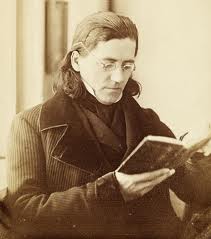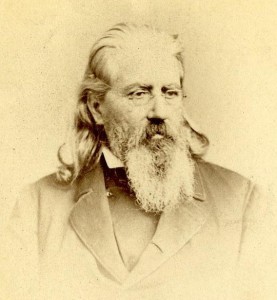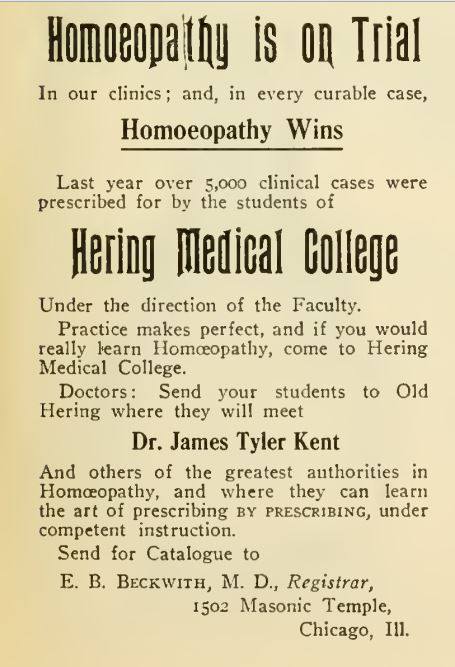Constantine Hering 1800 - 1880
January 26, 2008
 Constantine
Hering 1800 - 1880 The ‘father of American Homeopathy’, known for his
’Law of
Cure’
which guides modern homeopathy today as surely as it guided our
forebears.
Constantine
Hering 1800 - 1880 The ‘father of American Homeopathy’, known for his
’Law of
Cure’
which guides modern homeopathy today as surely as it guided our
forebears.
Hering originally set out to disprove homeopathy, but was converted instead, to become one of the most famous homeopaths of all time. Hering studied with Samuel Hahnemann and became the first President of the American Institute of Homeopathy when it was founded in 1844.
 Hering was present at the
meeting
at Frederick Hervey Foster
Quin’s
house when the British Homeopathic
Society
was
founded
in 1844.
Hering was present at the
meeting
at Frederick Hervey Foster
Quin’s
house when the British Homeopathic
Society
was
founded
in 1844.
Constantine Hering was the homeopath and the friend of Henry Clay (1777-1852)
In 1821, the campaign against Samuel Hahnemann was at its peak, C Baumgartner, the founder of a publishing house in Leipzig, wanted to publish a book against Homeopathy to finish the system.
Dr. Robbi was asked to write it, but he declined for want of time and recommended Constantine Hering, his young assistant. Constantine Hering was very pleased with this mark of confidence and started work on the project.
But while going through the writings of Samuel Hahnemann he came across the famous “Not a bene for my reviewers” in the preface of the third volume of the Materia Medica Pura which said among other things, “The doctrine appeals not only chiefly, but solely to the verdict of experience” - “repeat the experiments” it cries aloud, “repeat them carefully and accurately and you will find the doctrine confirmed at every step” - “and it does what no medical doctrine, no system of physics, no so called therapeutics did or could do, it insists upon being judged by the result.”
Constantine Hering decided to confirm the truth of the above remarks. He repeated the experiments with Cinchona and the results of Samuel Hahnemann were confirmed. Further study of homeopathic Materia Medica Pura and his experiments made him more convinced about Samuel Hahnemann’s ideas. The book against Homeopathy thus never saw the light of the day.
In 1824, an incident occurred which developed in him unshakable faith for Homeopathy. The fore finger of his right hand was cut while making a dissection on a dead body. The wound rapidly became gangrenous. The routine orthodox medical treatment had no effect. Ernst Kummer, a disciple of Samuel Hahnemann persuaded him to take homeopathic treatment and gave him Arsenic album. After a few doses he felt better and the gangrene was soon cured completely. Constantine Hering was surprised and became greatly interested in Homeopathy,
Hering studied with Samuel Hahnemann and became the first President of the American Institute of Homeopathy when it was founded in 1844.
Hering introduced the remedies lachesis, psorinum, indol and glonoin into our materia medica. His Foundation at the Hahnemann Hospital led to many more provings.
Having been introduced to the United States in New York City by Dr. Hans Burch Gram in 1825, homeopathy’s first epoch has been designated as 1825-1835 whereupon the first magazine, The American Journal of Homeopathia, was published by Drs. John Franklin Gray and Amos Gerald Hull.
Initially strong in New York and Pennsylvania where there was a greater percentage of German immigrants, homeopathy’s first school in the world was established in Allentown, PA, by Drs. Henry Detweiller and Constantine Hering with instruction only in German.
In late 1836, the first books were translated into English and published, Hahnemann’s Organon and Jahr’s Manual.
Constantine Hering, MD, the “father” of American homeopathy, was born on January 1, 1800 in the the town of Oschatz within the electorate of Saxony (now in Eastern Germany). He grew up in a religious household.
In 1817 he attended the Surgical Academy of Dresden for three years and from 1820 he studied medicine at Leipzig University.
He studied natural history, and in 1817 he studied surgery at an academy in Dresden. In 1820 he studied medicine in Leipzig. At Würzburg he continued the study of medicine under the famous Schönlein, the pathologist, and graduated with the highest honors of the university, receiving the degree of Doctor of Medicine in 1826.
While at Leipzig he was the student-assistant of a Dr Robbi, an antagonist of homeopathy. Robbi was approached by a local publisher to write a book about the homeopathic “heresy” but referred the publisher to Hering because of his own lack of time.
Hering enthusiastically pursued this task, studying the writings of Hahnemann, repeating provings, and undertaking other practical experiments as part of his research. During this period, Hering received a dissecting wound that became inflamed and infected. He was advised to have his hand amputated but sought homeopathic treatment and recovered.
As a result of the evidence from his own investigations, Hering transferred his allegiance. But instead of writing the negative review, he immediately quit the job and left the University to become one of the most influential proponents of homeopathy of all time.
Hering graduated from the University of Liepzig (in 1826). In his doctoral thesis titled, “On the Medicine of the Future”, Hering declared himself to be a homoeopath.
He taught the natural sciences and mathematics in the Blochmann Institute in Dresden, and in 1827 joined a botanical and zoological expedition under the protection of the King of Saxony to Suriname and Cayenne in South America. He remained in Suriname six years in charge of the zoological department of the expedition.
Soon after, the King attempted to prevent Hering from publishing his prolific homeopathic findings, but instead, Hering resigned the post and became the Physician-in-Attendance for the governor of Surinam’s capitol, Paramaribo.
Hering began focusing his attention on the discovery of new homeopathic remedies, the attenuation’s and freshly quilled-data of which he would send, by sea, to Samuel Hahnemann in Paris, and to John Ernst Stapf, his friend and publisher in Germany.
Hering accidentally proved the remedy Lachesis while he was triturating the Bushmasters venom in his home-laboratory in Paramaribo. He was attempting to find an improved substitute for the cowpox inoculation that Jenner was developing in Britain, which Hering felt was extremely dangerous and very heavy-handed for homeopathy.
Hering came forward in an English newspaper, and characterized all vaccination as a “poisoning of the blood.
"In Jennerian ([Edward Jenner](http://books.google.com/books?id=Mv9CvqVJUkcC&pg=PP15&dq=constantine+hering+Lachesis&ei=qnObR4fLDJaCiQGpuMGmCg&sig=B6rI1vjG2HAV28nkfx7rnkmSErw)) vaccination," he says, "there is the production of a real contagious disease, acting by zymosis or fermentation in the blood, thus endangering the organism, and resulting only in making the system less liable to, not proof against, the disease.
“Attention must likewise be called to the possibility of inoculating other diseases, such as itch, scrofula, leprosy, phthisis, syphilis, etc., and thus producing a complication of trouble difficult to be overcome.
“While the progress of our school has led us to a much more certain preventive, and also to an easy and certain and safe cure, the old school lost sight of Jenner altogether, and entirely forgot that the cows had also other diseases of the udder; and they lost sight of the only true origin of the true preventive cowpox, according to Jenner, and later Schonlein, in a peculiar disease of the horse’s feet, generally mistaken, and one not known to any of the vaccinating doctors.
“They went on vaccinating from arm to arm; and finally by the scabs, which often contained rotten and putrified animal matter.
“If it had been a poisoning even with the very best real cowpox, it now became a poisoning of nearly all children with the most horrible diseases; many even were murdered, and an infinite number poisoned for life.
“And smallpox epidemics appeared under the title of varioloid. It is, no doubt, an intolerable tyranny to compel vaccination by law. We are glad to be able to quote the words of a real statesman, the Count of Zedtwitz, who writes in a popular journal on Homoeopathy :
'Whether vaccination be useful or injurious, the subject of contention between men of science has very little to do with the question of compulsion.
> >‘This can only be determined by the convictions of the individual, which should be as inviolable in the domain of medicine as in that of religion or politics ; and coercion in this direction, which amounts to producing an artificial disease by bodily injury, can indeed be called nothing less than tyranny.
His interest and experience with snake venom led him to surmise that the saliva of a rabid dog, or powdered smallpox scabs, or any other disease products, viruses, or venom’s, might be prepared in the new Hahnemannian way to give a fail-safe method of curing disease.
In this manner Hering unwittingly became the first in the Isopathic movement (eventually, he also unwittingly paralyzed his right side from further self-testing or “prufung” of higher and higher attenuations of Lachesis).
George Henry Bute acquired a widespread reputation and great practice. and was joined in 1833 by his friend, Dr. Hering, from Paramaribo, and they worked together for some time. (This led to Constantine Hering’s return to Philadelphia, where he engaged in practice with Dr. Bute, locating on Vine street, below Fourth.)
He (later) affiliated with the Academy of Natural Sciences in Philadelphia, and made for the academy a cabinet of valuable collections and discoveries.
In January 1833, he reached Martha’s Vineyard, Massachusetts and immediately journeyed to Philadelphia, where he remained the rest of his life.
In 1835, together with Drs. Henry Detwiler, William Wesselhoeft, George Henry Bute and John Romig, he founded in Allentown the North American Academy of the Homoeopathic Healing Art. Dr. Hering became the first President and principal instructor. This was the first Homoeopathic School in the world. Constantine Hering and his colleagues also established the Hahnemannian Society, the first formal homeopathic society in America, and the second publication on homeopathy in America.
Dr. Hering taught, wrote books and pamphlets on homoeopathy and caused German text books on the subject to be translated into English.
He taught the principles of Hahnemann, practiced upon the sick, wrote books and pamphlets, caused German textbooks to be translated (including the Organon), and thus became the cornerstone around which and upon which his assistants and co-laborers clustered and leaned for support.
A financial crisis in 1837 forced the school to close. He continued his practice in Philadelphia and in 1847 he assisted in founding the Homoeopathic Medical College of Pennsylvania (Hering was a member of the faculty, retaining his chair until 1867) and in 1867 (he assisted in founding the Hahneman Medical College of Philadelphia, and held the chair of Materia Medica in this institution for two years) where he was Professor of Institutes and Materia Medica, 1867-69, and Professor Emeritus, 1869-1880.
Hering is famously known for his Law of Cure:
- The human body seeks to externalize disease—to dislodge it from more serious internal levels to more superficial external levels. Thus, someone with asthma may develop an external skin rash as part of the curative process.
- Healing progresses from the top of the body to the bottom. Thus, someone with arthritis in many joints will generally notice relief in the upper part of the body before the lower part.
- Healing proceeds in the reverse order of the symptoms. Thus, the most recent symptoms will generally be the first to be healed, and in the process of cure a person may re-experience previous symptoms.
Swedenborgianism (based on the work of Emanuel Swedenborg) and homeopathy took to each other at once. Swedenborgians found in homeopathy a medical system that perfectly complemented their religious attitude, while homeopaths found in Emanuel Swedenborg a religious framework into which Hahnemann’s ideas could expand freely.
Homeopathy thus quickly became the accepted medical system for Swedenborgians, while most of the leading nineteenth century homeopaths, including Hans Burch Gram and Constantine Hering, were Swedenborgians.
One of Hering’s passions, for he was a man of enormous curiosity and many interest, was to obtain a perfect collection of all the works by or pertaining to Paracelsus. He devoted nearly half a century to this pursuit. The fruits of his labour form one of the principal collections of works by and about Paracelsus. This collection, known as the Constantine Hering Collection, is now a part of the special collections of Hahnemann University. Housing over 200 volumes dating from 1502 — many in Latin and Old German — the collection, in addition to the original works of Paracelsus, includes early works on the philosopher’s stone, alchemy, botany, and a first edition of Robert Browning’s poem, Paracelsus. In 1881, a catalogue documenting the collection was published by Globe Publishing House and in 1932, Hahnemann Medical College and Hospital produced a second catalogue of the Constantine Hering Paracelsus Collection housed at the College.
Hering began organizing his voluminous notes into his still popular classic The Guiding Symptoms of Our Materia Medica the year before he died, in 1880, and it was completed by his students and published posthumously in 1891.
Hering was the first to use nitroglycerin (glonoin) in medicine for headaches and heart problems (30 years before its first use in orthodox medicine). It is an irony that he himself suddenly died one evening of a heart attack in 1880 after returning from a house call to a patient.
The minister for the Swedenborgian Church of New York City officiated at Hering’s funeral. One of Hering’s best friends was the Swedenborgian Minister of Philadelphia (information from Jerome Whitney).
Hering wrote The Condensed Materia Medica, The Homeopathic Domestic Physician, Homeopathic Family Physician, A Concise View of the Rise and Progress of Homœopathic Medicine, Analytical repertory of the symptoms of the mind, Celebration of the semi-centennial of the graduation in medicine of Constantine Hering, Analytical Therapeutics: Volume I, C. Hering’s Materia Medica: With a Pathological Index, Repertory to Hering’s Condensed Materia Medica, New Provings of the Following Remedies: Cistus Canadensis, A Memorial of Constantine Hering, The Twelve Tissue Remedies, of Dr. Schüssler, Recomended for Investigation, Symptomatic Indications of Typhoid Fever, The Treatment of Typhoid Fevers, with a Few Additions, The Last Events of 1867: The Telemicroscope of Gottlieb Juntz, A collection of miscellaneous biobibliographical material on this person, Heaven for Homoeopathy: An Historical Document, Hering’s Model Cures, Introductory Lecture to Course at Hahnemann College, The Family Adviser from Jahr’s Manual of Homœopathic Medicine _and most famously of all _The Guiding Symptoms of Our Materia Medica.

Of interest:
Walter Hering was an American Homeopath, and a friend of Richard Haehl.
William Hering 1803 - 1876 was a German orthodox physician, living in England, who converted to homeopathy.